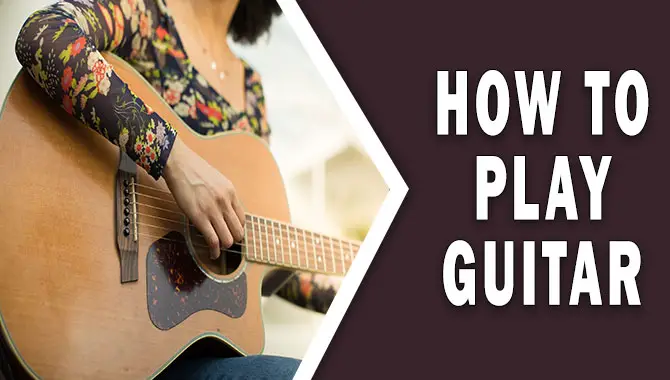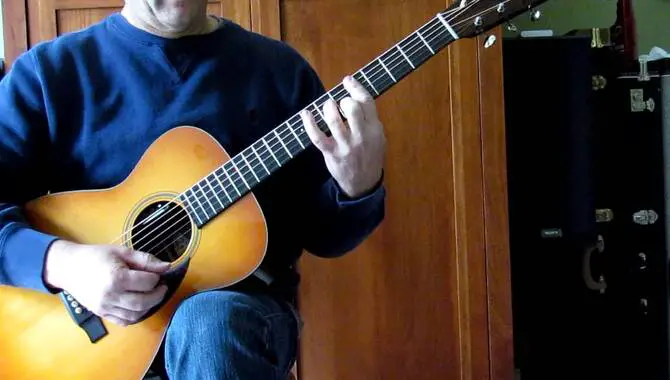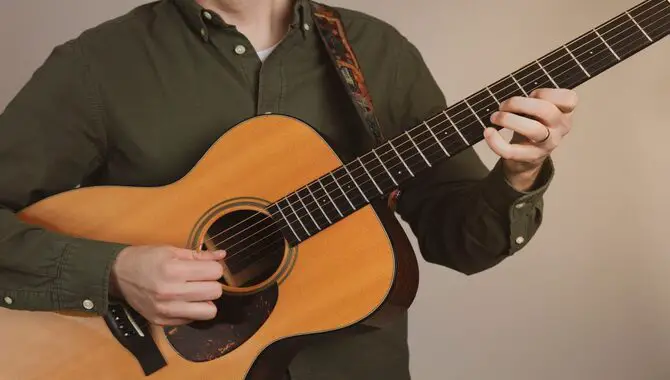Whether you want to play the guitar for fun or to be a professional musician, learning how to play the guitar is a great way to improve your musical skills. In this article, we’ll show you how to play guitar and provide some tips to help you get started.
When you’re first starting, it’s important to choose the right guitar. If you’re a beginner, we recommend opting for an acoustic guitar. Once you’ve got a feel for the basics, you can move on to an electric guitar.
Once you’ve got your guitar, you’ll need to learn how to hold it. The best way to do this is to sit comfortably with the guitar placed so the strings face you. It would be best to hold the guitar so that the neck is supported by your left hand and your right hand is placed over the strings.
Now that you’re holding the guitar correctly, you can learn how to play. The first thing you need to do is place your left hand in the middle of the strings and pluck the string with your right hand. Once you’ve got the hang of this, you can start to play chords. Chords are simply a combination of two or more notes played together. There are many different chords that you can learn, and you can find charts with all o

How Do I Hold The Guitar?

As a beginner guitarist, one of the first things you must learn is how to hold the guitar. This may seem simple, but if done incorrectly, it can lead to discomfort and even injuries. Here is a step-by-step guide on how to correctly hold the guitar:
- Sit in a comfortable position. You can either sit on a chair or the floor. If you’re sitting on a chair, make sure your feet are flat on the ground.
- Place the guitar in your lap. The guitar should be tilted so that the strings are facing you.
- Hold the guitar by the neck. Place your left hand on the neck and position your thumb in the space between the neck and hand.
- Place your right hand in the middle of the strings. Position your thumb behind the neck and your four fingers behind the strings.
- Adjust your position as needed. You may need to adjust your position slightly to be comfortable and reach all the strings.
Now that you know how to hold the guitar correctly, it’s time to start practicing!
How Do I Tune The Guitar?

When it comes to guitars, there are a lot of different ways to tune them. For example, you can use an electronic tuner or tune it by ear. You can also use a tuning fork or tune it with the piano.
Using an electronic tuner is probably a good idea if you’re starting. They are very easy to use, and they will make sure that your guitar is in tune. Just pluck the string, and the tuner will tell you what note it is. Then, you turn the tuning peg until the tuner says the note is in tune.
If you’re more experienced, you might want to try tuning by ear. This is a little bit more challenging, but it’s also more rewarding. To tune by ear, you need to listen to the note you’re trying to tune to adjust the tuning peg until the note sounds right.
You can also use a tuning fork to tune your guitar. Just strike the tuning fork, then hold it to the guitar string. The string should vibrate and make a sound. Adjust the tuning peg until the string vibrates at the same frequency as the tuning fork.
Finally, you can also tune your guitar with the piano. This is a great way to get it in tune if you don’t have an electronic tuner. Just find the note you’re trying to tune to on the piano, and then adjust the tuning peg until the note on the guitar sounds the same. So, there you have it! These are just a few different ways that you can tune your guitar. Just find the best method for you, and then stick with it.
What Are Some Basic Chords?

Chords are the building blocks of most guitar music. Without them, we’d be stuck strumming open strings all day. Chords are created when we stack two or more notes together. The most common chords are triads, built by stacking three notes on one another. To build a basic chord, we start with a root note—the note the chord is named after—and then stack two more notes above it. These two notes are called the third and the fifth of the chord.
For example, we want to build a C major chord. We start with a C note and then stack an E note (the third of a C chord) and a G note (the fifth of a C chord). We’ve got a C major chord when we play all three notes together. Pretty simple, right?
Now that we know how to build chords, let’s look at some of the most common chords you’ll encounter as a beginning guitarist. Remember, these are just a few infinite possibilities—experiment with different combinations of notes to create your unique chords.
Major Chords
Major chords are built by stacking the first, third, and fifth notes of a major scale on top of one another. For example, a C major chord is built by stacking the C, E, and G notes.
Minor Chords
Minor chords are built similarly to major chords but with a few key differences. First, we start with the major scale’s first, flat third, and fifth notes. For example, a C minor chord is built by stacking the notes C, Eb, and G. As you can see, the only difference between a C major and C minor chord is that the third note is flat in the minor chord. This gives the chord a slightly darker sound.
Seventh Chords
Seventh chords are major or minor chords with an added seventh note. For example, a C major seventh chord is built by stacking the notes C, E, G, and B. A C minor seventh chord is built by stacking the notes C, Eb, G, and Bb. As you can see, the only difference between these two chords is the flat seventh note.
Suspended Chords
Suspended chords are built by replacing the third or the fifth of a major or minor chord with the second or the fourth note of the major scale. For example, a Csus2 chord is built by stacking the notes C, D, and G. A Csus4 chord is built by stacking the notes C, F, and G. You’ll notice these chords don’t have a third, which gives them a very open sound. Now that you know some of the most common chords, get out there and start experimenting!
How Do I Strum The Guitar?

- Start by placing your thumb behind the guitar neck and wrapping your fingers around the strings.
- Use your thumb to pluck the string while simultaneously using your other fingers to hold down the string behind the guitar neck.
- When you pluck the string, use your wrist to brush the string downwards. This is called a down-stroke.
- Immediately after the down-stroke, brush the string upwards with your wrist. This is called an up-stroke.
- Continue alternating between down-strokes and up-strokes, ensuring the strokes are even and consistent.
That’s it! You’re now strumming the guitar! You can experiment with different rhythms and speeds as you become more comfortable with this basic strumming pattern. You can also try different strumming patterns, such as a down-stroke followed by two up-strokes (often used in reggae music) or a more complex pattern like triplets.
How Do I Read Guitar Tablature?
Guitar tablature, or tab for short, is a musical notation that tells guitarists where to place their fingers on the guitar strings to play a song. While standard notation tells musicians which notes to play, tablature tells guitarists which fret to hold down and which string to pluck.
If you’re new to reading tablature, it can initially look a bit daunting. But with a little practice, you’ll read the tab like a pro in no time! Here’s a step-by-step guide to reading guitar tablature:
- The vertical lines on a tablature staff represent the guitar strings, with the lowest-pitched string at the bottom and the highest-pitched string at the top.
- The numbers on the lines tell you which fret to hold down on that particular string. For example, if the number 3 is written on the bottom line, you should hold down the third fret on the bottom string.
- The symbols above the tablature staff tell you which strings to pluck. For example, above a particular string means that you should pluck that string open (without holding down any frets).
Now let’s combine all this and read a simple guitar tablature melody. The tablature staff below contains the melody to the children’s song Twinkle, Twinkle, Little Star. To play this melody, start by plucking the open first string (plucking above a string means plucking that string open).
Then, hold down the second fret on the second string and pluck that string. Next, pluck the open third string. Then, hold down the second fret on the fourth string and pluck that string. Finally, pluck the open fifth string. And that’s all there is to reading guitar tablature! You’ll read the tab like a pro in no time with a little practice.

I’m a writer and blogger who loves to talk about entertainment, culture, and relationships. I love to share my thoughts and insights on these topics, and I’m always looking for new ways to engage with my readers. I’m also a big fan of learning new things, so I’m always exploring new areas of interest.
